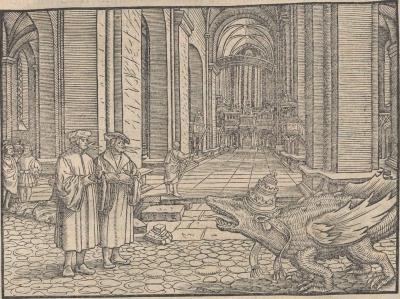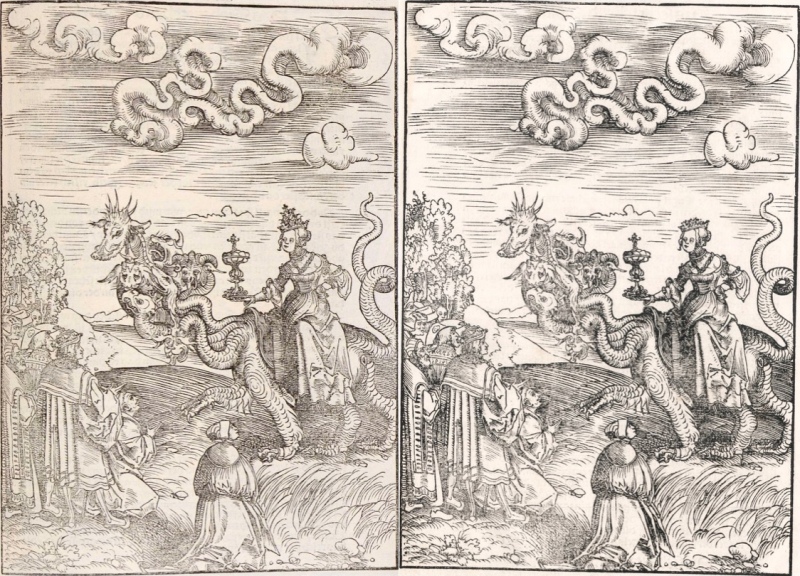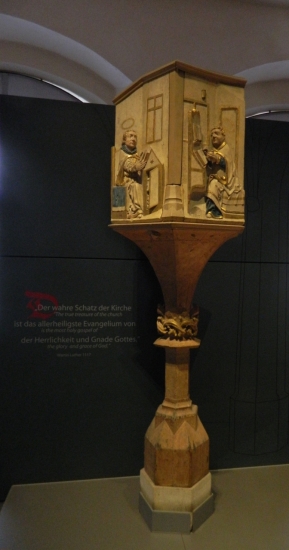Luther Visualized 17 – Smalcald Articles
November 20, 2017 Leave a comment
The Smalcald Articles
This figure was printed immediately above Revelation 13 in the first edition of Luther’s translation of the entire Bible (1534). That chapter first describes a seven-headed beast coming out of the sea, representing civil government in its antichristian aspect, and then a beast coming out of the earth with two horns like the Lamb but speaking like the Dragon, representing the Antichrist himself. About the second beast, the apostle John says, “He exercises all the authority of the first beast in his presence. And he makes the earth and its inhabitants worship the first beast… And he performs great signs so that he even makes fire come down from heaven to earth in the sight of men” (Rev 13:12,13). Notice that the artist portrayed the beast out of the earth wearing a monk’s cowl and cloak, as Lucas Cranach had in the 1522 New Testament.
At first Martin Luther was befuddled and frustrated about the refusal of the pope and his legates to hear him out and to join him in reforming the church on the basis of clear testimonies of Holy Scripture. But as he continued to study Scripture, he gradually came to a realization of what or whom he was actually up against. This growing suspicion was confirmed for him when on October 10, 1520, he received the pope’s bull (official decree) threatening his excommunication if he did not retract his teachings. The next day he wrote to his friend Georg Spalatin, the elector’s court secretary: “I feel much more free now that I am made certain that the pope is the Antichrist.”
Luther most clearly articulated his views on the Antichrist in the articles of faith he prepared in 1536 in preparation for a council that Pope Paul III had convoked, to be held in Mantua, Italy, in May 1537. Elector John Frederick had asked Luther to compose the articles on the Lutherans’ behalf. He wanted Luther to distinguish between articles of faith in which they could not yield anything without committing treason against God and his Word and articles in which they could perhaps yield something for the sake of Christian love without violating God’s word. But he also asked Luther for a confession that was clearer than the Augsburg Confession with respect to the pope.
Luther finished the rough draft in December 1536 and submitted it to seven other theologians. With very few changes it was unanimously adopted (though Melanchthon gave it a somewhat qualified subscription), and the elector was also pleased with it. The council never took place during Luther’s lifetime, but the confession Luther composed still gained widespread acceptance among Lutheran theologians in the following years. It became known as the Smalcald Articles because it was circulated and read at Schmalkalden by the large number of theologians and scholars that assembled there in February 1537. Even though it was never officially discussed or accepted there due to Melanchthon’s intrigues and Luther’s illness, Johannes Bugenhagen did present it to them for their voluntary, personal subscription after official business had been concluded, and 44 men signed it in all. It received official confessional status when it was included in the Book of Concord of 1580. (You can read it online here.)

MS (employed in Cranach’s studio), The Twenty-First Figure, woodcut, 1534. This image is based on Revelation 17. The great prostitute of Babylon, representing the unfaithful element within the visible Christian church, sits upon the seven-headed, ten-horned beast (Rev 13:1-10). In her left hand she holds “a golden cup…full of abominations and the filth of her adulteries” (17:4). Note also the triple-tiered papal tiara on her head.
The Smalcald Articles stand out in at least three ways. First, Luther presents the doctrine of justification by God’s grace alone through faith in Christ alone as the core of Scripture from which all other scriptural doctrine emanates and radiates. Second, he also gave a clearer confession about the Lord’s Supper than even the Augsburg Confession did. And third, he also gave a clear confession about the bishop of Rome. He wrote:
[T]here stand all [the pope’s] bulls and books, in which he roars like a lion…that no Christian can be saved without being obedient and subject to him in all that he wishes, all that he says, all that he does. … All of this powerfully demonstrates that he is the true christ of the end times or Antichrist, who has opposed and exalted himself over Christ [cf. 2 Thessalonians 2:4]. For he will not permit Christians to be saved apart from his power, even though his power is nothing, neither established nor commanded by God. … Finally, it is nothing but the devil himself at work when [the pope] pushes his lies about masses, purgatory, the monastic life, and human works and worship [cf. Mark 7:6-8] (which is in fact the essence of the papacy) over and against God, and condemns, kills, and harasses all Christians who do not exalt and honor this abomination of his above all things.

Lucas Cranach’s Studio, woodcut opposite Chapter 11 of Revelation in the September 1522 edition of Luther’s translation of the New Testament (left) and the December 1522 edition (right). Note the difference between the beast’s crown in each.
Once Luther was convinced that the Roman papacy was the Antichrist, he wasted no time making it known in his writings and using the artist at his disposal, Lucas Cranach, to reinforce it visually. He had Cranach portray “the beast that comes up from the Abyss” with the triple-tiered papal tiara to accompany Revelation 11 in the first edition (September 1522) of his translation of the New Testament. Probably at the complaint of the Imperial Council of Regency (Reichsregiment), the papal tiara had to be replaced in the second edition (December 1522) by a simple crown.

MS (employed in Cranach’s studio), The Fifteenth Figure, woodcut, 1534. This image corresponds to Cranach’s images from 1522 above.
However, when Luther’s translation of the entire Bible was being prepared for publication in 1534, and the as-yet-unidentified MS from Cranach’s workshop was preparing woodcuts for it based in large part on Cranach’s previous woodcuts, the triple-tiered papal tiara was restored. (See image on the right.)
Christoph Walther, a proofreader and typesetter in Hans Lufft’s print shop in Wittenberg, confirmed that Luther wasn’t just responsible for the translation, but also for much of the artwork:
Luther himself dictated to some extent how the figures in the Wittenberg Bible were supposed to be depicted and portrayed, and demanded that the content of the text be portrayed and depicted in the simplest way, and he would not tolerate anything superfluous or useless that did not benefit the text getting smeared in with the rest.

Lucas Cranach’s Studio, woodcut opposite Chapter 17 of Revelation in the September 1522 edition of Luther’s translation of the New Testament (left) and the December 1522 edition (right). Note the difference between the prostitute’s crown in each. These images were the basis for MS’s The Twenty-First Figure above.
Sources
Dr. Wilhelm Martin Leberecht de Wette, ed., Dr. Martin Luthers Briefe, Sendschreiben und Bedenken, erster Theil (Berlin: G. Reimer, 1825), pp. 238ff (no. 127), 419f (no. 204), 494f (no. 262)
Friedrich Bente, Historical Introductions to the Lutheran Confessions (St. Louis: Concordia Publishing House, 2005), pp. 109-138
Hans Lietzmann, Heinrich Bornkamm, et al., eds., Die Bekenntnisschriften der evangelisch-lutherischen Kirche, 2nd ed. (Göttingen: Vandenhoeck & Ruprecht, 1955), pp. xxiv-xxvii
Martin Brecht, Martin Luther: Shaping and Defining the Reformation (Minneapolis: Fortress Press, 1990), pp. 46-56
Martin Brecht, Martin Luther: The Preservation of the Church (Minneapolis: Fortress Press, 1993), pp. 95-102,178-185
Stephan Füssel, Die Luther-Bibel von 1534: Ein kulturhistorische Einführung (Cologne: Taschen, 2012), pp. 43-44,61
The September (New) Testament (1522)
The December (New) Testament (1522)
“Die Schmalkaldischen Artikel” in the Weimarer Ausgabe, vol. 50, pp. 160ff, esp. pp. 213ff



